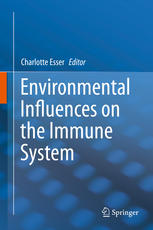تاثیرات محیطی بر سیستم ایمنی بدن ۲۰۱۶
Environmental Influences on the Immune System 2016
دانلود کتاب تاثیرات محیطی بر سیستم ایمنی بدن ۲۰۱۶ (Environmental Influences on the Immune System 2016) با لینک مستقیم و فرمت pdf (پی دی اف)
| نویسنده |
Charlotte Esser |
|---|
| تعداد صفحهها |
378 |
|---|---|
| نوع فایل |
|
| حجم |
6 Mb |
| سال انتشار |
2016 |
89,000 تومان
معرفی کتاب تاثیرات محیطی بر سیستم ایمنی بدن ۲۰۱۶
این کتاب مقالاتی را درباره این موضوع جمع آوری می کند که چگونه محیط به سیستم ایمنی بدن شکل می دهد.
به طور کلی فرض بر این است که سیستم ایمنی به عوامل بیماری زا مضر مانند باکتری ها و ویروس ها پاسخ می دهد. با این حال، باکتری های بی ضرر، مواد شیمیایی، استرس، غذای معمولی و سایر عوامل نیز می توانند باعث تحریک، شکل دهی یا تداخل با سیستم ایمنی شوند که اغلب منجر به اثرات نامطلوب می شود. با این حال، به طور فزاینده ای پذیرفته می شود که برخی از این واکنش ها فیزیولوژیکی هستند و برای یک سیستم ایمنی سالم ضروری هستند.
نمونه هایی از اثرات نامطلوب شامل اثرات سرکوب کننده سیستم ایمنی پرتو فرابنفش یا اثرات ایمنی سمی مواد شیمیایی مصنوعی مانند هیدروکربن های آروماتیک چند حلقه ای است. خودایمنی یا آلرژی می تواند یک نتیجه منفی از تعامل بین سیستم ایمنی و ترکیبات شیمیایی مانند داروها باشد. اثرات مثبت می تواند از سطوح طبیعی قرار گرفتن در معرض باکتری ها، شیوه زندگی سالم یا رژیم غذایی باشد.
نیاز زیادی به درک نحوه عملکرد ارتباط بین محیط و سیستم ایمنی وجود دارد. این کتاب این نیاز را برآورده می کند. عوامل محیطی (مانند باکتری ها و قرار گرفتن در معرض نور خورشید)، عوامل انسانی (مانند سن، ورزش یا استرس) و عوامل مهم انسان ساخته (مانند آلودگی هوا) را پوشش می دهد. فصلی درباره حقوق بشر مکمل فصول علمی است. این کتاب برای ایمونولوژیست ها، سم شناسان و محققانی در نظر گرفته شده است که می خواهند بدانند سیستم ایمنی چگونه کار می کند و چگونه تحریک می شود، و همچنین برای پزشکان در پزشکی محیط زیست و عموم علاقه مندان به ایمونولوژی.
This book brings together articles on the overarching theme of how the environment shapes the immune system.
The immune system is commonly assumed to respond to harmful pathogens such as bacteria and viruses. However, harmless bacteria, chemicals, stress, normal food and other factors can also trigger, shape or interfere with the immune system, often producing adverse effects. Yet, it is also becoming increasingly accepted that some of these interactions are physiological and necessary for a healthy immune system.
Examples of negative effects include the immunosuppressive effects of UV irradiation, or the immunotoxic effects of man-made chemicals such as polycyclic aromatic hydrocarbons. Autoimmunity or allergies can be the adverse consequences of interaction between the immune system and chemical compounds such as drugs. Positive effects can come from natural exposure levels to bacteria, healthy life-style or the diet.
There is a great need to understand how communication between the environment and the immune system works. This book addresses this need. It covers environmental factors (such as bacteria, sun exposure), human factors (such as age, exercise or stress), and important man-made factors (such as air pollution). A chapter on human rights complements the scientific chapters. The book is intended for immunologists, toxicologists and researchers who want to know how the immune system works and is triggered, as well as for medical doctors in environmental medicine and the general public interested in immunology.




